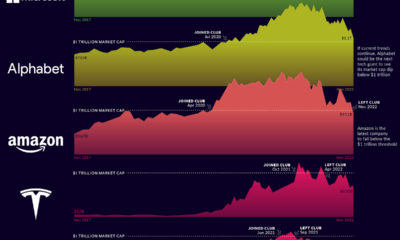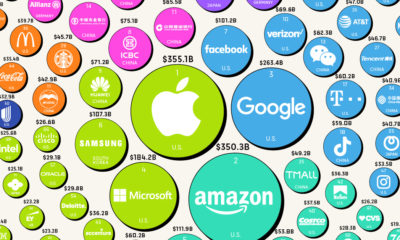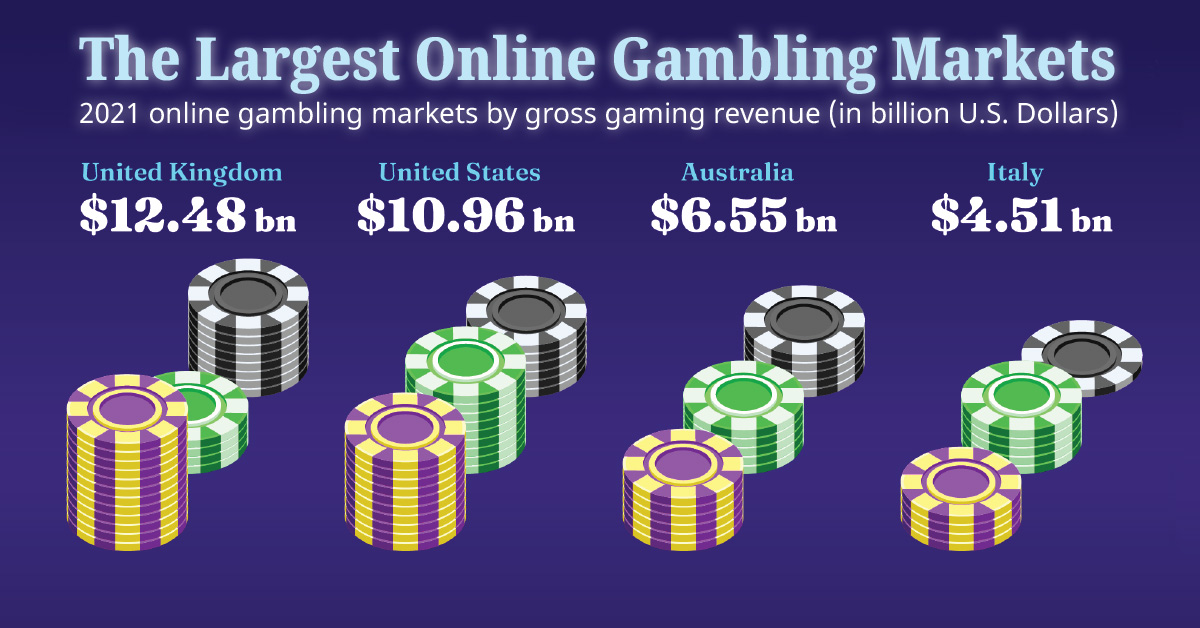Every year it feels like the gaming industry sees the same stories—record sales, unfathomable market reach, and questions of how much higher the market can go. We’re already far past the point of gaming being the biggest earning media sector, with an estimated $165 billion revenue generated in 2020. But as our graphic above helps illustrate, it’s important to break down shifting growth within the market. Research from Pelham Smithers shows that while the tidal wave of gaming has only continued to swell, the driving factors have shifted over the course of gaming history.
1970–1983: The Pre-Crash Era
At first, there was Atari. Early prototypes of video games were developed in labs in the 1960s, but it was Atari’s release of Pong in 1972 that helped to kickstart the industry. The arcade table-tennis game was a sensation, drawing in consumers eager to play and companies that started to produce their own knock-off versions. Likewise, it was Atari that sold a home console version of Pong in 1975, and eventually its own Atari 2600 home console in 1977, which would become the first console to sell more than a million units. In short order, the arcade market began to plateau. After dwindling due to a glut of Pong clones, the release of Space Invaders in 1978 reinvigorated the market. Arcade machines started to be installed everywhere, and new franchises like Pac-Man and Donkey Kong drove further growth. By 1982, arcades were already generating more money than both the pop music industry and the box office.
1985–2000: The Tech Advancement Race
Unfortunately, the gaming industry grew too quickly to maintain. Eager to capitalize on a growing home console market, Atari licensed extremely high budget ports of Pac-Man and a game adaptation of E.T. the Extra Terrestrial. They were rushed to market, released in poor quality, and cost the company millions in returns and more in brand damage. As other companies also looked to capitalize on the market, many other poor attempts at games and consoles caused a downturn across the industry. At the same time, personal computers were becoming the new flavor of gaming, especially with the release of the Commodore 64 in 1982. It was a sign of what was to define this era of gaming history: a technological race. In the coming years, Nintendo would release the Nintendo Entertainment System (NES) home console in 1985 (released in Japan as the Famicom), prioritizing high quality games and consistent marketing to recapture the wary market. On the backs of games like Duck Hunt, Excitebike, and the introduction of Mario in Super Mario Bros, the massive success of the NES revived the console market.
Estimated Total Console Sales by Manufacturer (1970-2020)
Source: Wikipedia Nintendo looked to continue its dominance in the field, with the release of the Game Boy handheld and the Super Nintendo Entertainment System. At the same time, other competitors stepped in to beat them at their own game. In 1988, arcade company Sega entered the fray with the Sega Mega Drive console (released as the Genesis in North America) and then later the Game Gear handheld, putting its marketing emphasis on processing power. Electronics maker Sony released the PlayStation in 1994, which used CD-ROMs instead of cartridges to enhance storage capacity for individual games. It became the first console in history to sell more than 100 million units, and the focus on software formats would carry on with the PlayStation 2 (DVDs) and PlayStation 3 (Blu-rays). Even Microsoft recognized the importance of gaming on PCs and developed the DirectX API to assist in game programming. That “X” branding would make its way to the company’s entry into the console market, the Xbox.
2001–Present: The Online Boom
It was the rise of the internet and mobile, however, that grew the gaming industry from tens of billions to hundreds of billions in revenue. A primer was the viability of subscription and freemium services. In 2001, Microsoft launched the Xbox Live online gaming platform for a monthly subscription fee, giving players access to multiplayer matchmaking and voice chat services, quickly becoming a must-have for consumers. Meanwhile on PCs, Blizzard was tapping into the Massive Multiplayer Online (MMO) subscription market with the 2004 release of World of Warcraft, which saw a peak of more than 14 million monthly paying subscribers. All the while, companies saw a future in mobile gaming that they were struggling to tap into. Nintendo continued to hold onto the handheld market with updated Game Boy consoles, and Nokia and BlackBerry tried their hands at integrating game apps into their phones. But it was Apple’s iPhone that solidified the transition of gaming to a mobile platform. The company’s release of the App Store for its smartphones (followed closely by Google’s own store for Android devices) paved the way for app developers to create free, paid, and pay-per-feature games catered to a mass market. Now, everyone has their eyes on that growing $85 billion mobile slice of the gaming market, and game companies are starting to heavily consolidate.
Major Gaming Acquisitions Since 2014
After seeing the success that games like Pokémon Go had on smartphones—reaching more than $1 billion in yearly revenue—and Grand Theft Auto V’s record breaking haul of $1 billion in just three days, companies are targeting as much of the market as they can. And with the proliferation of smartphones, social media games, and streaming services, they’re on the right track. There are more than 2.7 billion gamers worldwide in 2020, and how they choose to spend their money will continue to shape gaming history as we know it. on The start of internet gambling or virtual gambling provided enthusiasts with an avenue to spend their time (and money) at the click of a button from anywhere in the world. Today, these digital casinos have turned into a multibillion-dollar industry in some countries. This graphic by Louis Lugas Wicaksono uses data from the H2 Gambling Capital—as cited by The Guardian—to highlight the countries with the largest regulated online gambling markets.
Biggest Online Gambling Markets in 2021
Gross online gaming revenue globally was estimated to have reached a whopping $102 billion in 2021. Here are the largest markets on a per-country basis. Far and away at the top of the rankings, the UK ($12.5B) narrowly surpasses the U.S. ($11B) as the largest online gambling market in the world. Next up is Australia ($6.5B) in third, comparatively with roughly half of the UK’s gaming spend. Europe features prominently on the top 10 list, including Italy, France, Germany, Sweden, Spain, and Greece. Notably, no countries from Asia, South America, or Africa feature in the top 10. That’s despite some Asian countries having higher economic outputs and GDP per capita metrics than some of the featured European countries.
The True Cost of Gambling Revenue
Online gambling markets rose to new heights of popularity during the COVID-19 pandemic, as people were pushed into isolation with only time and the internet for company. In turn, this raised concerns of gambling addiction and its impacts, including crime. England alone saw close to 3,000 cases of theft, fraud, and other gambling-related crimes between 2019 and 2020. Governments have now started pushing for policy changes to control these issues before it is too late.













